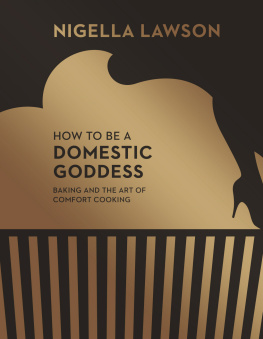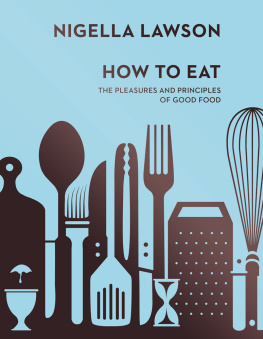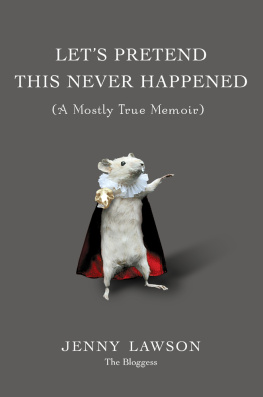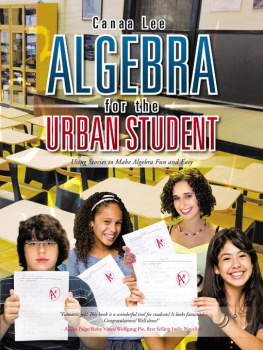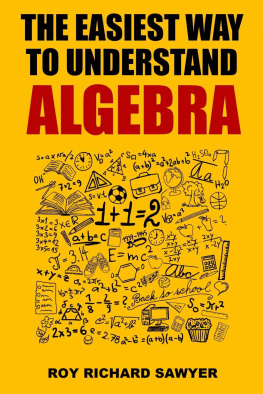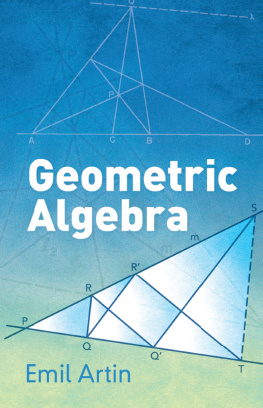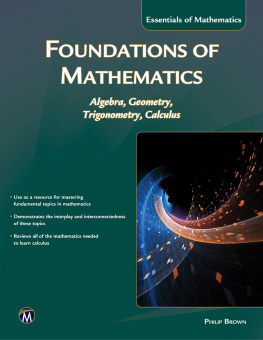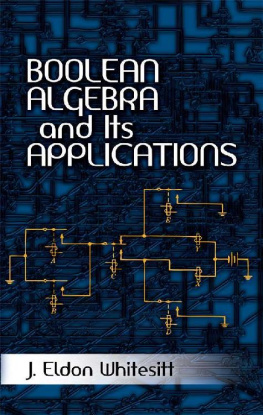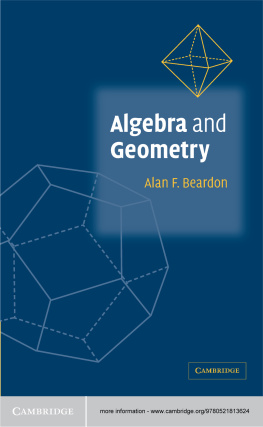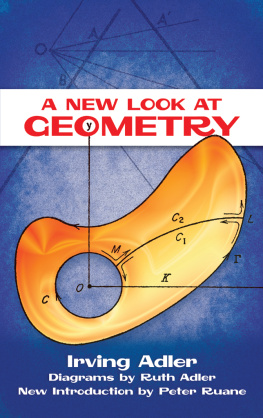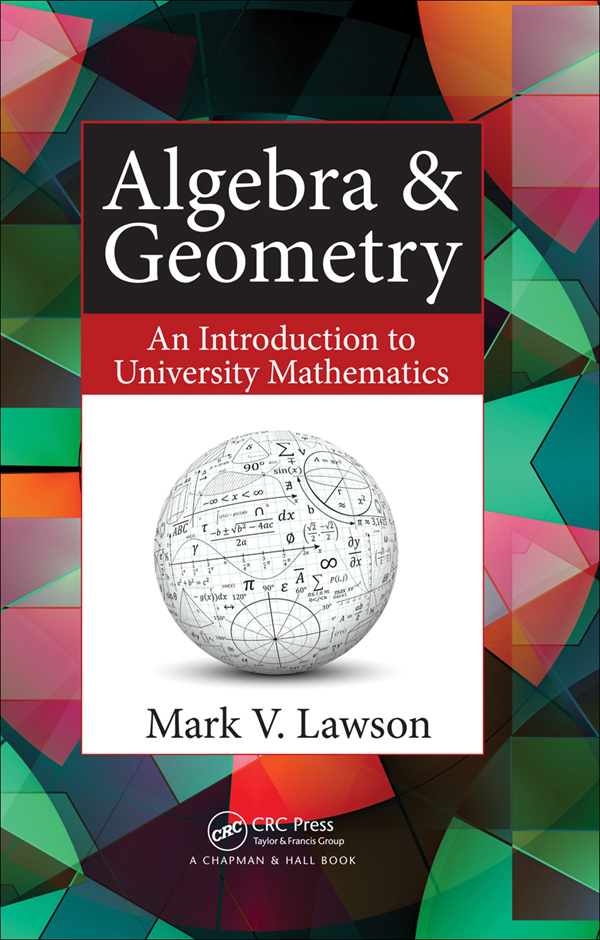Algebra &
Geometry
An Introduction to
University Mathematics
Algebra &
Geometry
An Introduction to
University Mathematics
Mark V. Lawson
Heriot-Watt University
Edinburgh, UK

Contents
Landmarks
CRC Press
Taylor & Francis Group
6000 Broken Sound Parkway NW, Suite 300
Boca Raton, FL 33487-2742
2016 by Taylor & Francis Group, LLC
CRC Press is an imprint of Taylor & Francis Group, an Informa business
No claim to original U.S. Government works
Version Date: 20160603
International Standard Book Number-13: 978-1-4822-4649-0 (eBook - EPUB3)
This book contains information obtained from authentic and highly regarded sources. Reasonable efforts have been made to publish reliable data and information, but the author and publisher cannot assume responsibility for the validity of all materials or the consequences of their use. The authors and publishers have attempted to trace the copyright holders of all material reproduced in this publication and apologize to copyright holders if permission to publish in this form has not been obtained. If any copyright material has not been acknowledged please write and let us know so we may rectify in any future reprint.
Except as permitted under U.S. Copyright Law, no part of this book may be reprinted, reproduced, transmitted, or utilized in any form by any electronic, mechanical, or other means, now known or hereafter invented, including photocopying, microfilming, and recording, or in any information storage or retrieval system, without written permission from the publishers.
For permission to photocopy or use material electronically from this work, please access www.copyright.com (http://www.copyright.com/) or contact the Copyright Clearance Center, Inc. (CCC), 222 Rosewood Drive, Danvers, MA 01923, 978-750-8400. CCC is a not-for-profit organization that provides licenses and registration for a variety of users. For organizations that have been granted a photocopy license by the CCC, a separate system of payment has been arranged.
Trademark Notice: Product or corporate names may be trademarks or registered trademarks, and are used only for identification and explanation without intent to infringe.
Visit the Taylor & Francis Web site at
http://www.taylorandfrancis.com
and the CRC Press Web site at
http://www.crcpress.com
In Memoriam
WILLIAM HENRY LAWSON
24th April 1915, Ypres
CHARLES PEIRCE ECCLESHALL
6th June 1915, Gallipoli
The aim of this book is to provide a bridge between school and university mathematics centred on algebra and geometry. Apart from pro forma proofs by induction at school, mathematics students usually meet the concept of proof for the first time at university. Thus, an important part of this book is an introduction to proof. My own experience is that aside from a few basic ideas, proofs are best learnt by doing and this is the approach I have adopted here. In addition, I have also tried to counter the view of mathematics as nothing more than a collection of methods by emphasizing ideas and their historical origins throughout. Context is important and leads to greater understanding. Mathematics does not divide into watertight compartments. A book on algebra and geometry must therefore also make connections with applications and other parts of mathematics. I have used the examples to introduce applications of algebra to topics such as cryptography and error-correcting codes and to illustrate connections with calculus. In addition, scattered throughout the book, you will find boxes in smaller type which can be read or omitted according to taste. Some of the boxes describe more complex proofs or results, but many are asides on more advanced material. You do not need to read any of the boxes to understand the book.
The book is organized around three topics: linear equations, polynomial equations and quadratic forms. This choice was informed by consulting a range of older textbooks, in particular [] are freely available online.
Exercises. One of my undergraduate lecturers used to divide exercises into five-finger exercises and lollipops. I have done the same in this book. The exercises, of which there are about 250, are listed at the end of the section of the chapter to which they refer. If they are not marked with a star (*), they are five-finger exercises and can be solved simply by reading the section. Those marked with a star are not necessarily hard, but are also not merely routine applications of what you have read. They are there to make you think and to be enjoyable. For further practice in solving problems, the Schaums Outline Series of books are an excellent resource and cheap secondhand copies are easy to find.
Prerequisites. If the following topics are familiar then you probably have the background needed to read this book: basic Euclidean and analytic geometry in two and three dimensions; the trigonometric, exponential and logarithm functions; the arithmetic of polynomials and the roots of the quadratic; experience in algebraic manipulation.
Organization. The book is divided into two sections. .
set the tone for the whole book and in particular attempt to explain what proofs are and why they are important.
need be read first. Everything else can be read when needed or when the fancy takes you.
. It is partly revision but mainly an introduction to properties that are met with time and again in studying algebra and are likely to be unfamiliar.
form an introduction to linear algebra. I have organized each chapter so that the more advanced material occurs towards the end. The three themes I had constantly in mind whilst writing these chapters were:
The solution of different kinds of algebraic equation.
The nature of the solutions.
The interplay between geometry and algebra.
Wise words from antiquity. Mathematics is, and always has been, difficult. The commentator Proclus in the fifth century records a story about the mathematician Euclid. He was asked by Ptolomy, the ruler of Egypt, if there was not some easier way of learning mathematics than by reading Euclids big book on geometry, known as the Elements. Euclids reply was correct in every respect but did not contribute to the popularity of mathematicians. There was, he said, no royal road to geometry. In other words: no shortcuts, not even for god-kings. Despite that, I hope my book will make the road a little easier.
Acknowledgements. I would like to thank my former colleagues in Wales, Tim Porter and Ronnie Brown, whose Mathematics in context module has influenced my thinking on presenting mathematics. The bibliography contains a list of every book or paper I read in connection with the writing of this one. Of these, I referred to Archbold [] the most and regard it as an unsung classic. My own copy originally belonged to Ruth Coyte and was passed onto me by her family. This is my chance to thank them for all their kindnesses over the years. The book originated in a course I taught at Heriot-Watt University inherited from my colleagues Richard Szabo and Nick Gilbert. Although the text has been rethought and rewritten, some of the exercises go back to them, and I have had numerous discussions over the years with both of them about what and how we should be teaching. Thanks are particularly due to Lyonell Boulton, Robin Knops and Phil Scott for reading selected chapters, and to Bernard Bainson, John Fountain, Jamie Gabbay, Victoria Gould, Des Johnston and Bruce MacDougall for individual comments. Sonya Gale advised on Greek. At CRC Press, thank you to Sunil Nair and Alexander Edwards for encouraging me to write the book, amongst other things, Amber Donley, Robin Lloyd-Starkes, Katy E. Smith, and an anonymous copy-editor for producing the book, and Shashi Kumar for technical support. I have benefited at Heriot-Watt University from the technical support of Iain McCrone and Steve Mowbray over many years with some fine-tuning by Dugald Duncan. The



